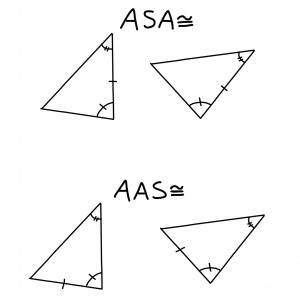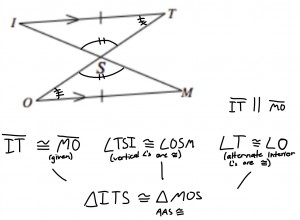AAS Congruence and ASA Congruence
To find if two triangles are congruent you have to take a few things into consideration. You have to understand what the given lengths and angles are telling you about the size and shape of the triangle and ignore the visual appearance. In many different situations, all you need to confirm congruence is two sets of congruent, corresponding angles and one set of congruent, corresponding sides. These sides and angles have to be proven congruent, either by using the given information or other theorem. The placement of the side determines what kind of congruence condition proves that they are congruent. If there are two angles side by side with the side outside of it, like triangles ABC and DEF, then the condition is AAS, angle angle side, congruence. If the side is between the angles, like triangles UVW and XYZ, then the congruence condition is ASA, angle side angle, congruence.
Using Flow Charts
Flow charts are used to help organize information to help prove that two triangles are congruent. Usually the information is put into bubbles that then connect until you have enough information to prove the congruence. First you would write the given information, things like the measurements of angles and sides, parallel lines and congruent sides and angles. This information would be written at the top of the flow chart. The given information could also prove different theorems that prove the sides and or angles to be congruent. Under these you would write the corresponding sides or angles that this information proves to be congruent. With every piece of information you would label if the information was given or if there was a theorem that proved it. After there is enough information to prove the whole triangle is congruent, then you would write the congruence statement such as triangle ABC is congruent to triangle XYZ along with the congruence condition.
Triangle Congruence Conditions
There are five different ways to prove that two triangles are congruent. For any of these congruence conditions you need either congruent, corresponding sides, angles or a combination of the two. The first congruence condition is AAS (angle angle side) congruence where there are two pairs of congruent, corresponding angles and one congruent corresponding side on two triangles. With this specific congruence condition the side is on the out side of the angles. ASA (angle side angle) congruence is also with two pairs of congruent, corresponding angles and one pair of congruent, corresponding sides. In this case the congruent side are between the two angles. The third condition is SAS (side angle side) congruence. This is where there are two pairs of congruent sides and one pair of congruent angles. For this statement to be true the angles have to be between the two sides. Another congruence statement is SSS (side side side) congruence. This is when all of the corresponding sides are congruent. The final condition is exclusively for right triangles. This is HL (hypotenuse leg) congruence. If two right triangles have congruent, corresponding legs and or hypotenuses then the rest of the triangle is congruent. These conditions are all true because only congruent triangles can have those qualities and if they were changed then the rest of the triangle would not be congruent either.
Determining a Midpoint
To determine a midpoint of a diagonal line on a graph then you would have to use separate lengths of two different lines, one vertical and one horizontal, that would make a right triangle using the diagonal line. You would take half of the length of the vertical leg and either subtract that from the greater y value or add it to the lesser y value of one of the points that the diagonal line connects. This value would be the y value of the midpoint of the diagonal line. You would then take half the value of the horizontal leg of the triangle and either subtract that from the x value or add it to the lowest x value of the points. With the x and y values you would have the coordinates for the midpoint of the diagonal line.







Leave a Reply